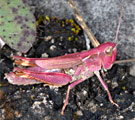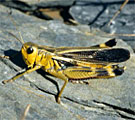Gomphocerus sibiricus (Linnaeus, 1767)
![Gomphocerus sibiricus: Male (Alpes-Maritimes, August 2010) [N] Gomphocerus sibiricus: Male (Alpes-Maritimes, August 2010) [N]](thumbs/acrididae/sibiricus_m2011.jpg)
![Gomphocerus sibiricus: Male frontal (Alpes-Maritimes, August 2011) [N] Gomphocerus sibiricus: Male frontal (Alpes-Maritimes, August 2011) [N]](thumbs/acrididae/sibiricus_2m2011.jpg)
![Gomphocerus sibiricus: Male [N] Gomphocerus sibiricus: Male [N]](thumbs/acrididae/sibiricus_m.jpg)
![Gomphocerus sibiricus: Male frontal: bubble-like expanded front tibiae [N] Gomphocerus sibiricus: Male frontal: bubble-like expanded front tibiae [N]](thumbs/acrididae/sibiricus_mf.jpg)
![Gomphocerus sibiricus: Female [N] Gomphocerus sibiricus: Female [N]](thumbs/acrididae/sibiricus_w.jpg)
![Gomphocerus sibiricus: Female [N] Gomphocerus sibiricus: Female [N]](thumbs/acrididae/sibiricus_w2.jpg)
![Gomphocerus sibiricus: Female (Alpes-Maritimes, August 2010) [N] Gomphocerus sibiricus: Female (Alpes-Maritimes, August 2010) [N]](thumbs/acrididae/sibiricus_w2011.jpg)
![Gomphocerus sibiricus: Female (Alpes-Maritimes, August 2010) [N] Gomphocerus sibiricus: Female (Alpes-Maritimes, August 2010) [N]](thumbs/acrididae/sibiricus_2w2011.jpg)
![Gomphocerus sibiricus: Many locust (mostly G. sibiricus) at a humid, mineral-riche place [N] Gomphocerus sibiricus: Many locust (mostly G. sibiricus) at a humid, mineral-riche place [N]](thumbs/acrididae/sibiricus_versammlung.jpg)
![Gomphocerus sibiricus: Habitat: stony slopes and alpine pastures [N] Gomphocerus sibiricus: Habitat: stony slopes and alpine pastures [N]](thumbs/acrididae/sibiricus_h.jpg)
Habitat:
Gomphocerus sibiricus inhabits pastures, rupicolous dwarf shrub, scree slopes or embankments. Mostly It occurs mostly on very sunny and more dry places. In Central Europe Gomphocerus sibiricus occurs only in the Alps from about 1200m above sea level.
Life cycle:
The adults usually occur from July to October. Gomphocerus sibiricus draws attraction easily by its loud stridulation.
Endangerment factors:
In Germany Gomphocerus sibiricus is only locally present in the Bavarian Alps. Gomphocerus sibiricus is only locally endangered through tourism (ski slopes, etc.) and intensive agricultural use of fertilizers (manure etc.) even at higher altitudes.
Remarks:
Gomphocerus sibiricus occurs in Europe in the mountains (Northern Spain, Pyrenees, Alps, central Apennines, Carpathians, Balkans). In addition, the grasshopper is known from the Caucasus and from central and eastern Asia (Siberia, Kamchatka, parts of China, etc.).


